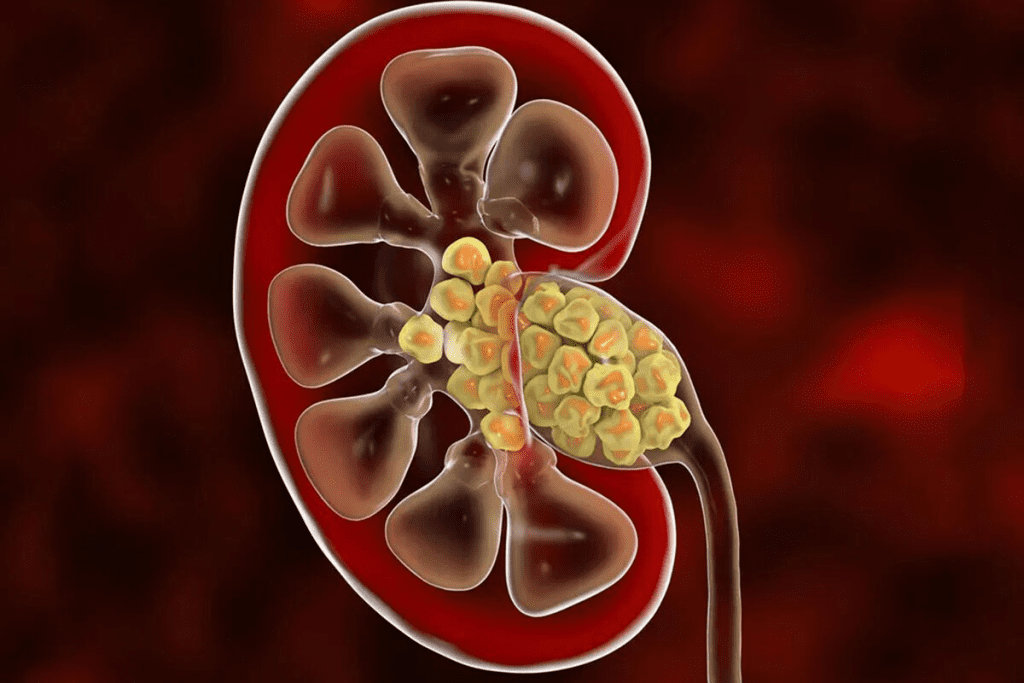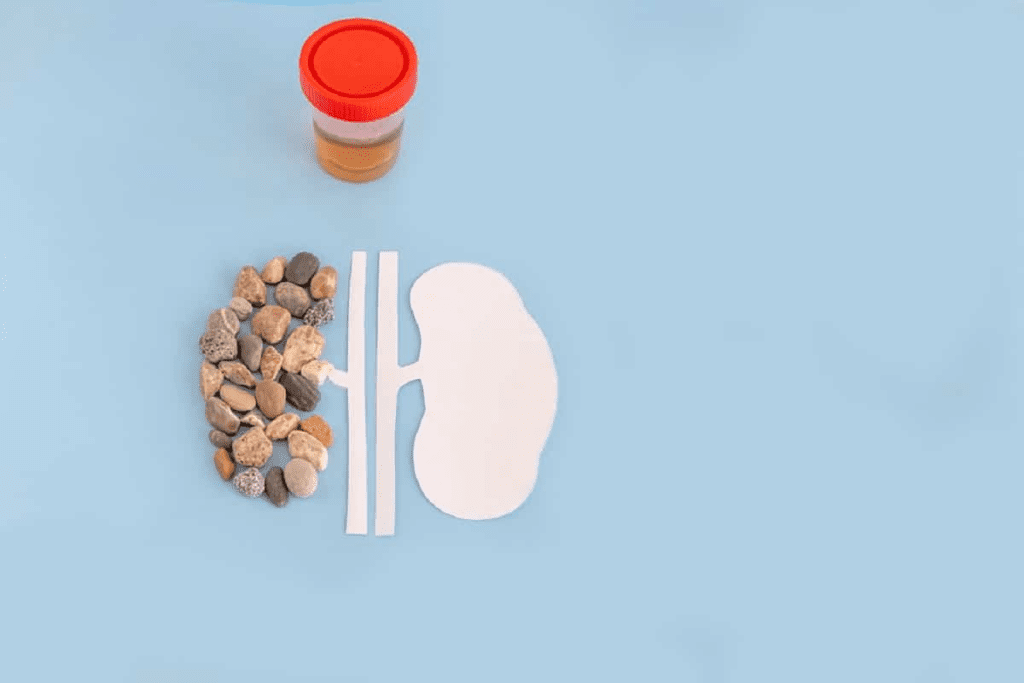Last Updated on November 25, 2025 by
Dealing with kidney stones can be very worrying and painful. A 7 mm kidney stone is seen as quite big by doctors. Many studies show that stones smaller than 5 mm have about an 80% chance of passing on their own. Stones between 4“7 mm have a 60% chance, and stones bigger than 7 mm have only a 30% chance without help.

Our hospital helps patients from all over with detailed support. We know that kidney stones of 6-7 mm might need medical help. Our goal is to offer the best treatments that meet global standards.

Knowing the size of a kidney stone is key to finding the right treatment. Stones are measured in millimeters. Their size affects how likely they are to pass on their own.
Doctors use tests like ultrasound or CT scans to measure stones. These tests give accurate sizes. For example, 6mm is about 0.24 inches, 5mm is 0.2 inches, and 25mm is roughly 1 inch.
The size of a stone is important for its treatment. Stones are sorted by size, location, and type. Big stones can cause pain, block the urinary tract, and increase infection risk.

We sort kidney stones by size, location, and type for tailored treatments. Knowing a stone’s size and details helps us choose the best treatment. This ensures the best outcome for the patient.
A 7 mm kidney stone is very important. It’s big enough to affect how doctors treat it. We’ll look at what makes a stone “large” and how likely it is to pass on its own.
In medicine, a “large” kidney stone is one that’s big and might cause problems. Stones over 7 mm are seen as big because they’re less likely to pass without help. The European Association of Urology says stones 7 mm or bigger might need surgery or other treatments. This is because they could block the flow of urine, cause infections, or harm the kidneys.
The size of a kidney stone matters a lot for passing it on its own. Stones under 5 mm have an 80% chance of passing. But, stones between 4“7 mm have only a 60% chance. And stones over 7 mm have just a 30% chance. This shows why a 7 mm stone is a big deal and might need special care.
It’s important to know how kidney stones impact the urinary system. This helps us understand why we need to see a doctor quickly. The urinary system includes the kidneys, ureters, bladder, and urethra. It filters waste and excess fluids from our body.
The urinary tract is complex, and kidney stones can disrupt it a lot. The kidneys filter waste and make urine, which goes down the ureters to the bladder. Then, it’s expelled through the urethra. A blockage, like a kidney stone, can cause a lot of pain and serious problems.
A kidney stone can stay in the kidney or move down the urinary tract. If it gets stuck in the ureter, it blocks urine flow. This leads to kidney stone pain that is very severe.
Bigger stones, like those over 7 mm, often get stuck in the ureter. The ureter is narrow, and big stones can block it, stopping urine flow. This blockage causes kidney stone symptoms like severe pain, nausea, and vomiting.
Big stones can cause infections or damage to the kidneys if not treated. So, it’s key to see a doctor if symptoms get worse or don’t go away.
Knowing the signs of a 7 mm kidney stone is key to getting the right treatment. We’ll look at the usual symptoms and pain patterns. We’ll also talk about when you should get medical help right away.
A 7 mm kidney stone can lead to severe pain in the flank or belly, nausea, and vomiting. This pain, called renal colic, is very intense. It might spread to the lower belly or groin. You might also feel the need to pee a lot and see hematuria (blood in your pee).
The pain from kidney stones is unique. It starts suddenly and might come with fever and chills if you have an infection. The pain is usually so bad that you’ll need to see a doctor.
If you have severe pain that won’t go away, vomiting blood, a fever over 101.5 °F (38.6 °C), signs of infection, or trouble peeing, get help fast. These could mean you have a blockage or an infection in your urinary tract.
Keep an eye on your symptoms and get medical help if they get worse or if you see signs of infection. Quick action can stop serious problems and help you feel better sooner.
Diagnosing kidney stones involves several tests to confirm their presence and characteristics. Our institution uses a detailed approach to ensure accurate diagnosis. This way, we can provide the right care for our patients.
The steps to diagnose kidney stones are:
Medical experts say, “Imaging tests are key for accurate kidney stone diagnosis and treatment planning.”
“The use of CT scans has revolutionized the diagnosis of kidney stones, allowing for precise detection and characterization.”
After the tests, it’s important to understand the results. Our healthcare team will explain everything in detail. This includes the size, location, and type of kidney stone, if found.
The imaging results help us:
By understanding the diagnostic process and test results, we can create a treatment plan that fits your needs.
There are several ways to treat a 7 mm kidney stone. Each method has its own benefits and things to consider. The right treatment depends on the stone’s location, your health, and any complications.
Before treatment, you’ll need to get ready. We suggest telling your doctor about any medicines you’re taking. Some might need to be changed or stopped. You might also need to fast before the treatment.
For a 7 mm kidney stone, you might have Extracorporeal Shock Wave Lithotripsy (ESWL), Ureteroscopy (URS), or Retrograde Intrarenal Surgery (RIRS). Each has its own use and benefits.
After treatment, you might feel some pain or discomfort. This can usually be managed with pain medicine. We also recommend drinking lots of water to help pass the stone fragments. The time it takes to recover can vary based on the procedure and your health.
To prevent kidney stones, we need to make changes in our diet, drink more water, and change our lifestyle. Knowing what causes kidney stones helps us take steps to avoid them.
Diet is key in preventing kidney stones. Drinking more water is important, but so are other diet changes. Here’s what we suggest:
These diet changes can greatly lower the chance of new stones forming.
Drinking enough water is vital to prevent kidney stones from coming back. We suggest drinking at least 2 liters of water a day. Also, making lifestyle changes can help:
By making these diet, hydration, and lifestyle changes, we can lower the risk of getting kidney stones again. We help our patients create plans that fit their needs and health.
A 7 mm kidney stone is big and usually needs a doctor’s help. Knowing about kidney stones, their signs, and how to treat them is key.
Liv Hospital stresses the need for quick doctor visits for kidney stones. Spotting kidney stone symptoms early can greatly improve treatment results.
We talked about different treatment choices for kidney stones. We also highlighted the value of prevention to lower the chance of more stones. Eating right and changing your lifestyle can help prevent kidney stones.
We aim to give full care and support to those with kidney stones. We want the best results for everyone. If you’re worried about kidney stones, please see a doctor.
Symptoms include severe pain and frequent urination. You might also see nausea or blood in your urine. Knowing these signs is key to getting medical help quickly.
We measure kidney stones in millimeters. Their size affects how likely they are to pass on their own. Stones over 7 mm often need medical help to pass.
Treatments for 7 mm stones include ESWL, URS, and RIRS. We explain how to prepare, the procedures, and what to expect after.
To prevent stones, change your diet, drink plenty of water, and make lifestyle changes. Knowing what causes stones helps you take action.
A 7 mm stone is big and unlikely to pass on its own. As stones get bigger, passing them naturally gets harder. This shows why seeing a doctor is important.
Big stones can block the ureter, causing a lot of pain. Knowing how the urinary system works helps understand the pain and risks.
We use many tools to find and size stones. This helps us decide the best treatment. We explain each step and what the results mean.
Look for severe pain and frequent urination. These signs mean you might have a stone. We’re here to help you get the care you need.
Liv Hospital offers top-notch care and support for international patients. We aim to provide the best treatments, following global standards, for your health.
Subscribe to our e-newsletter to stay informed about the latest innovations in the world of health and exclusive offers!